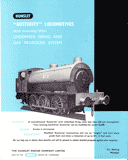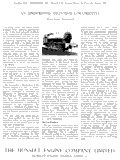Austerity
0-6-0st type as modified by L.D.Porta & Hunslet
 |
The Austerity 0-6-0st type came about during World War II when it was realised a heavy duty shunting loco was required for UK and, ultimately, mainland European service. The design was so successful that 485 were built for military and industrial service. The design was based on an amalgam of previous Hunslet designs simplified for war time conditions.
In the early 1960s, in
a bid to meet stringent restrictions on smoke emissions, Ing. L.D.Porta was
commissioned by the Hunslet company to design certain modifications. Hunslet had become aware of Porta technology when, unsuccessfully, bidding for the contract to build the second batch of 75cm gauge 2-10-2 locomotives for RFIRT, Argentina.
Research suggests the locomotives may not have been quite as Porta would have wished. It is felt something could have been lost 'in the translation' between Argentina and the UK. However despite some shortcomings these locomotives did serve an important purpose in the development of steam. They were the very first application of Porta's work outside of his native Argentina.
Some locos were built with the modifications
whilst other locomotives were returned for modification or even modified
at NCB works through the supply of conversion kits. A
few other types of locomotive were similarly modified around the same time.
It is not generally recognised that Hunslet remain the greatest users of Porta technology in terms of the number of locomotives modified or fitted from new outside of Argentina.
|
All figures are as built and thus prior to any later modifications undertaken.
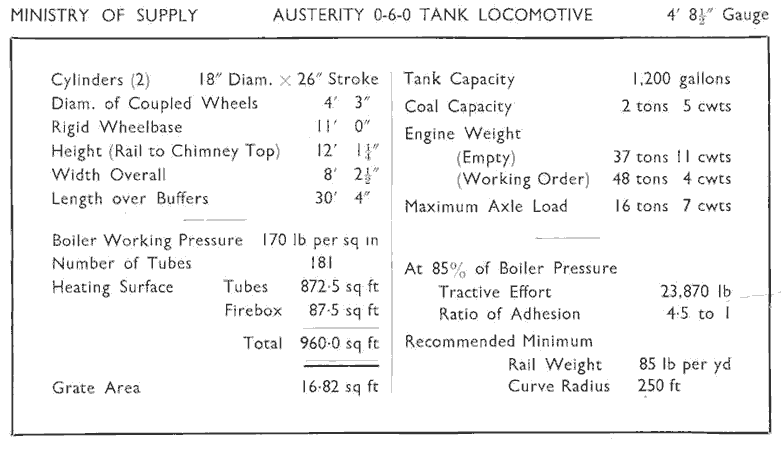

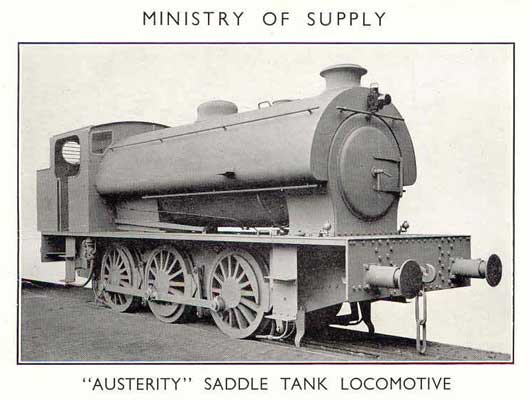
The Modifications
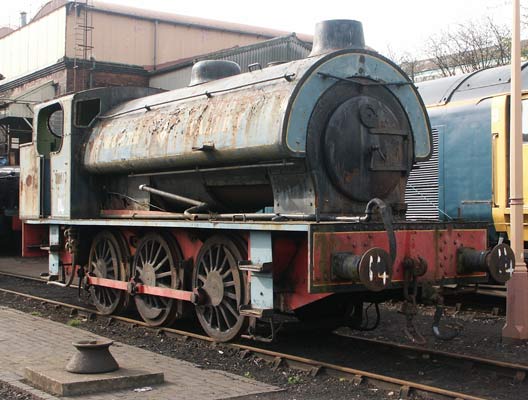 |
'Austerity'
0-6-0st type RSH No. 7289 'Fred' sits at Tyseley Locomotive Works. A give away to the presence of modification is the vacuum/smoke regulator on the upper part of the smokebox door and the distinctive chimney shape. 13 April 2003. |
One
locomotive believed to have received the full set of modifications is Robert Stephenson & Hawthorn built No.7289.
This loco, built in 1945, initially worked as part of the War Department fleet
as number 71480 before moving to industrial use in the North West of England. It is thought to have been modified in late 1963.
In preservation the loco was initially based on the Keighley & Worth Valley
Railway. To read a little about the history of this loco, known as Fred, click
here.
In
April 2003 this locomotive, then part of the Somerset & Dorset Locomotive
Collection, arrived at Tyseley Locomotive Works for assessment. Although partially
demodified the opportunity was been taken to study the remaining modifications.
Several of the photographs on this page show certain aspects of this locomotive. All photographs
of 'Fred' were taken on April 13 2003.
 |
'Austerity'
type 0-6-0st RSH No. 7289 'Fred' sits at Tyseley Locomotive Works. 13 April 2003. |
The Combustion System
The key parts of the combustion system are illustrated in the diagram below. In essence Hunslet employed a version of Porta's Gas Producer Combustion System (GPCS).
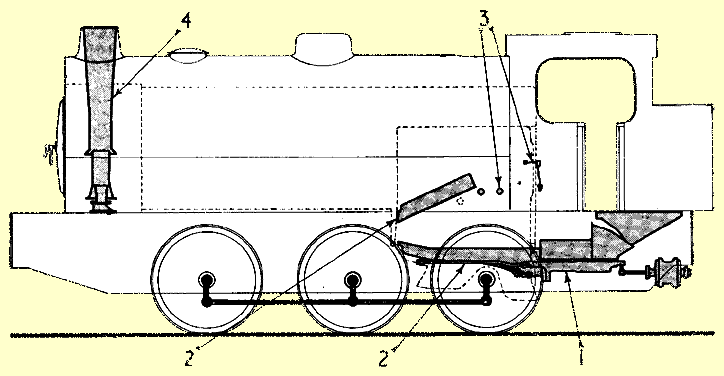
1 - The underfeed stoker; 2 - Parts of the gas producer combustion
system; 3 - Secondary air inlet and control; 4 - The Kylpor exhaust system
As
can be seen above the locomotives received an underfeed stoker, GPCS and a modified exhaust ejector system in the form of a Kylpor
(see the section below). The locos could be single manned, if required, mainly through the provision of the underfeed stoker. The GPCS
system included clinker control steam from the stoker and cylinder exhausts and a rocking or drop section grate depending on the locomotive in question.
Starting at the coal bunker the base was modified with the construction of a hopper to feed the trough of the underfeed stoker. Initial stokers were arranged with two feeding systems working alternatively but later the system changed to the single feed system illustrated below. The later version of stoker consisted of a ram driven by an reciprocating steam engine which pushed the charge of coal along a trough. This trough lead under the rear section of the grate prior to delivering the coal to the middle of the grate where is would form something of a hump. It was anticipated the action of the the draught etc would more evenly spread the coal over the grate. A small rocking section of grate existed around the end of the stoker trough.
 |
This hopper fed coal from the bunker above into the underfeed stoker trough via the hatch shown. Obviously on this example the stoker has been removed! 10 June 2006 |
The stoker was designed to handle small coal - down to "half-inch singles". If not fed with the correct size of coal the stoker would not perform as required.
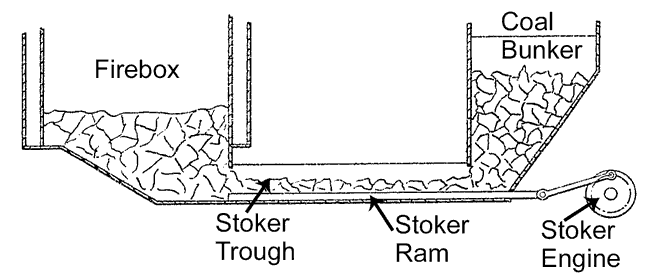 |
A schematic of the underfeed stoker system as patented by Hunslet. Diagram adapted from UK patent 929,486. |
It should be remembered that with a non-cyclonic GPCS firebox the best fire shape is evenly thick across the grate, not as provided by the underfeed stoker. Not too surprisingly many crews did not get on too well with the stoker but others, especially where the locomotives were worked very hard and supplied with the correct coal, did. So it is unclear at this time if the problems experienced were down to an inappropriate application of technology, inadequate training of crews and maintenance staff (if any actually occurred at all!) or a combination of both.
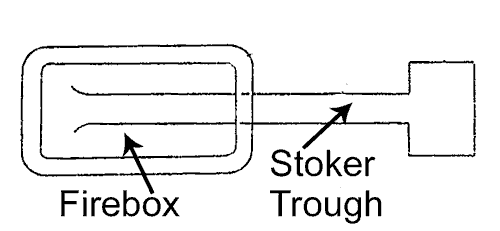 |
A basic plan view of the underfeed stoker as applied to the Austerities. Diagram adapted from UK patent 929,486. |
It was normal practice to leave the stoker engine running as they were found to be temperamental pieces of equipment. A vertical sliding plate was provided that could be dropped into the stoker trough preventing further coal from being fed onto the grate.
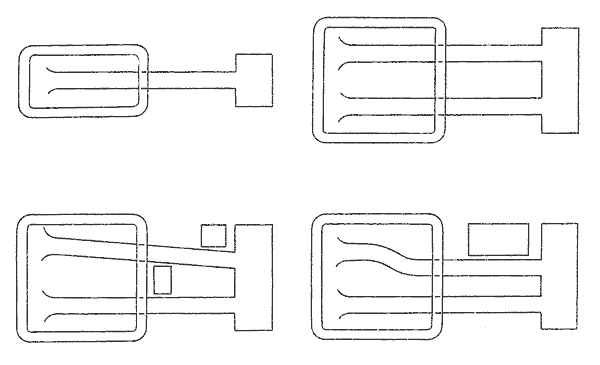 |
Note surprisingly UK patent 929,486, in the name of the Hunslet (Holdings) Ltd, contained variations of the underfeed stoker. The diagrams contained within were provided to show various options considered possible. |
One problem noted was the ability of the fire to creep back down the stoker trough when the locomotives were standing. It was not unknown for bunkers to be found alight if a locomotive was left with a fire on the grate overnight or for a similar length of time!
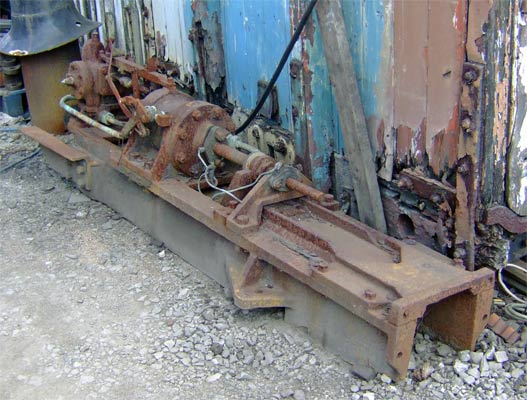 |
A general view of what is believed to be the only remaining underfeed stoker. This one is upside down with the open ended trough being the end which would have been closest to the grate. 11 June 2006 |
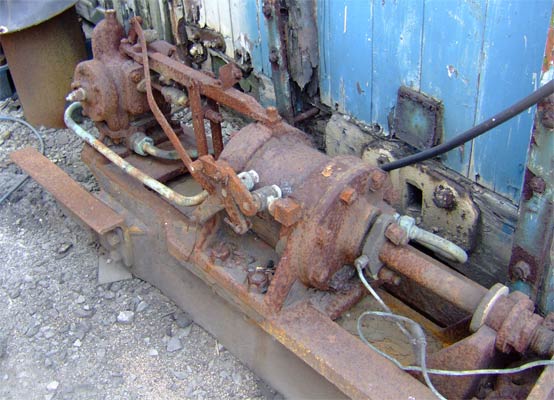 |
A closer view of the steam cylinder side of the underfeed stoker also showing the piston rod as attached the the ram. 11 June 2006 |
 |
A view along the stoker trough looking from the grate end. The red arrow points to one part of the ram system used to push the coal towards the grate. 11 June 2006 |
 |
The underfeed stoker took up quite a bit of room underneath the locomotive. The stokers, at the bunker end, were quite vulnerable hanging down as they did. So stoker equipped locomotives were also fitted with a protector plate, seen here in black, attached to the buffer beam of locomotive 'Wheldale'. 11 June 2006 |
Below grate level stoker and cylinder exhaust along with some live steam was mixed with the primary air. This is an essential part of the gas producer process as applied by Porta. Whilst not strictly required to obtaining producer gas it aids the chemistry and assists in keeping the firebed temperature below the ash fusion point thus reducing clinker formation considerably.
Hunslet publicity states a rocking grate was fitted to the locomotives, but these did not extend across the entire grate area. It is important to keep the firebed as free from ash as possible with perhaps the easiest way of achieving this being regular, but gentle, grate shaking. The precise nature of the grate is uncertain and it is almost certainly the case there were many different 'standards'! Several sources suggest certain locos were equipped with standard type grates with the addition of a drop section at the front. Whilst better than nothing this also explains why many refer to the locos as very powerful but bad fire throwers. An essential part of the GPCS is a restricted primary air grate. At the time of this work Porta's preferred grate was the Hulson type but he shortly moved on to the pin hole type. Without such a restricted air grate the strong draught created at the front end would have created channeling in the fire bed above the gaps between the standard type firebars. This would have caused entrainment of even fairly large coal particles leading to them being expelled at the chimney. A Hulson type grate would have prevented this and ensured better gas production. Alternatively the Kylpor exhaust could have been tuned to the conditions prevailing but this is not such a simple task, would have required an greater understanding of the system than probably prevailed and would have been somewhat pointless if Gas Producer combustion was to be achieved.
 |
'Austerity'
0-6-0st type RSH No. 7289 'Fred' sits at Tyseley Locomotive Works. Note the
vacuum brake pipework
on the running plate - a preservation days addition. I assume it was not always
in the position seen! 13 April 2003. |
Above grate level the standard arrangement was for 3 over-fire air holes to be provided on each side of the firebox. No crown over-fire air holes were provided. The over-fire air holes provided the bulk of the air used in the combustion process - with the GPCS the coal on the grate is burnt endothermically thus releasing combustible gases into the firebox. This gas then burns exothermically releasing large amounts of heat. Some of the advantages of this approach include less carryover of unburnt fuel from the firebed, more complete and thus cleaner combustion and a virtual elimination of clinker formation.
 |
 |
An approximate comparison of the firebox layout as built (left) and as modified (right). In the modified image the overfire air holes are in the correct position, replacing the appropriate stays. The exact length of the combustion arch on the modified loco is uncertain so the arch illustrated is a best guess. |
It is known certain locos were not fitted with firebox side over-fire airholes. Rather secondary air was supplied by placing hollow bricks in the front corners of the grate. Their precise nature is uncertain at this time. But clearly they will have reduced the available grate area and may well have been susceptible to become blocked with coal. It is also true such a system would have given less than ideal gas mixing in the firebox.
 |
A
general view in to the firebox through the firehole door. 13 April 2003 |
 |
On
the lefthand side of the firebox the rear two overfire air holes for the GPCS are visible but the front one is hidden by the brick arch. This is not how it should be! 13 April 2003 |
 |
Two
of the three overfire air holes for the GPCS in the lefthand side of the
firebox on RSH No. 7289. 13 April 2003 |
 |
All three overfire air holes for the GPCS are visible on the righthand side of the firebox on RSH No. 7289. Note the standard grate and incorrect angle brick arch. 13 April 2003 |
 |
These
three holes in the firebox side cladding should line up with the overfire
air holes! 13 April 2003 |
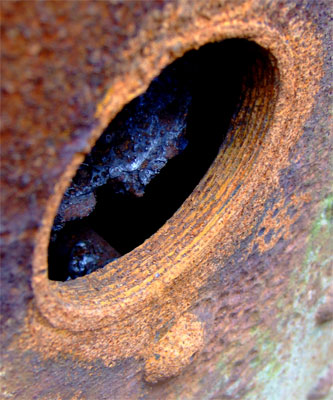 |
The over-fire air hole tubes each take the location of a stay. Thus they can be seen as hollow stays. As this photograph shows the tubes used were screwed into the firebox walls. 11 June 2006 |
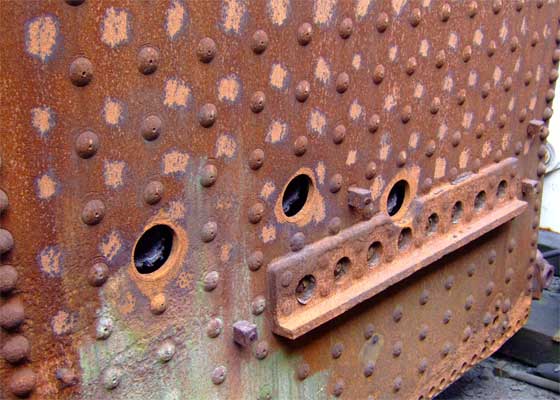 |
In addition to the 'Austerity' type other locomotives were given GPCS fireboxes. This example is from locomotive No.2414 of the 50550 class, a forerunner of the 'Austerity' type. In this case the firebox mounting plate had to be modified to accommodate the front most over-fire air hole on each side. The 'Austerity' type has the mounting plate in a different location. 11 June 2006 |
As shown in the diagram towards the top of this page Hunslet identified a part of the GPCS as being above the firehole. Steam was provided at the protector ring level when the throttle was open. It is quoted that this was to aid complete combustion.
 |
UK patents 937,719 demonstrates the purpose of the steam admitted around the firehole. The idea was to force gases created in the fire under the combustion arch thus ensuring more complete combustion. On the Austerity locomotives the steam was admitted at the firehole protector level as illustrated here and not at the deflector plate as previously stated. The patent also covered admission of steam from the sides of the firebox. Diagram adapted from UK patent 937,719. |
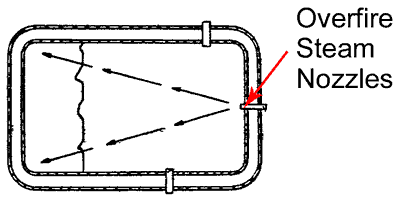 |
A plan view of the patented system showing the spread of the steam. Diagram adapted from UK patent 937,719. |
 |
The remains of the special protector plate showing the nozzle area. Unfortunately this particular example has been burnt away in the crucial area! The pipe leading down at the rear of the plate is the steam feed. © Richard Moffatt |
The brick arch was modified from the normal type employed to better suit the conditions required by the GPCS but at this time details are not to hand as to the form of this arch. The GPCS normally employs a longer than normal arch as a general aid to combustion but also as it helps to prevent firebed carryover.
It is not believed a special firehole door or deflector plate such as the type used at Rio Turbio, home of the GPCS, were fitted, which they ought to have been for best results.
The Exhaust System
As ever the exhaust system is the heart of the locomotive. An incorrect exhaust system will put the entire locomotive out of balance. The modified locomotives all employed the Kylpor exhaust system. At this time it was Porta's system of choice having been extensively employed within Argentina. Development of the now well known Lempor system was still underway at this time.
The Kylpor Exhaust System
 Taken from the writing's of L.D.Porta: Taken from the writing's of L.D.Porta:
"Kylpor Exhaust System: Whilst this is derived from the Kylchap it differs in that the diffuser is of shorter length with wider angle and in the reduced length, with angling of the Kyläla exhaust splitter to give some swirling action to the exhaust stream, to obtain maximum performance from the diffuser without losing contact between the boundary layer of the exhaust steam and the diffuser walls. The swirling motion imparted to the exhaust stream also provides a self-cleaning action and obviates the need for self-cleaning plates in the smokebox."
Source - STEAM LOCOMOTIVE DEVELOPMENT IN ARGENTINA - ITS CONTRIBUTION TO THE FUTURE OF RAILWAY TECHNOLOGY IN THE UNDER-DEVELOPED COUNTRIES - Paper No. 721 of the Institution of Locomotive Engineers, presented before the Manchester Centre of the Institution on 7th March, 1969.
"The Kylpor Ejector
The Kylpor differentiates from the Lempor by the fact that it makes use of the Kyläla four lobe mixing device and therefore resembling the Kylchap of the type 1K/1T. Both types are thermodynamically equivalent except that the Kylpor has greater friction in the mixing chamber, this leading to the written preferences for the Lempor in recent designs. Nevertheless, the design is worthy of application in the case of a double concentric tuyère. In this design, the inner smaller tuyère is connected to the cylinder during the release phase, while both- the inner and the larger- gives an extra area during the exhaust phase. This larger area determines a very low back pressure on the exhaust line and the explanation is to be sought in the fact that actually most of the work is done by the puffing steam through a very small tuyère and thereby extracting a good deal of work of the incomplete expansion toe of the indicator diagram.It can be shown that the upper mixing chamber of the Kylpor must be cylindrical while the bottom gas section and the tuyère must be equal to that of the tip of the Kyläla petticoat. Unlike former designs, there is no interest in having a uniform distribution of velocities at the Kyläla exit and therefore this element should be as short as possible to reduce the unavoidable friction."
Source - THEORY OF THE LEMPOR EJECTOR AS APPLIED TO PRODUCE DRAUGHT IN STEAM LOCOMOTIVES - L.D.Porta 1974 |
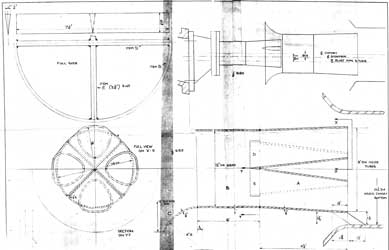 |
A drawing showing parts of the Kylpor exhaust arrangement, taken from NCB drawings, can be viewed by clicking here. |
The Austerity type was equipped from new with a the typical type of plain blast pipe arrangement which bore no relation to the science of thermodynamics, very much a rule of thumb, 'good enough', arrangement. As the GPCS requires a higher smokebox vacuum, remembering that the majority of the combustion gases are pulled through the 6 overfire airholes of relatively small diameter, and greater turbulence in combustion gas flow redraughting was essential hence the use of the Kylpor type.
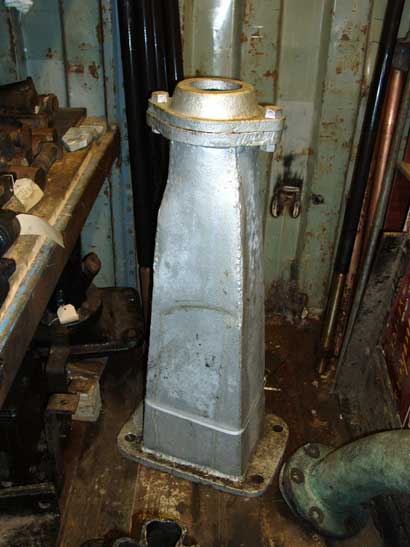 |
Something akin to the standard plain blast pipe arrangement as applied to the Austerity type - a 'could not be worse' type of arrangement. This particular item has, at some point, been modified by the NCB, but not in any useful thermodynamic way! 04 December 2005 |
Working up from the base of the smokebox, the first item to be found in the new system, which was bolted to the original manifold, was a Kordina. The Kordina is used to reduce the pressure in the opposite cylinder's exhaust pipe. The simplest explanation of how the Kordina works is to compare it to a simple ejector, such as a vacuum ejector, where a pressurised stream of steam passes across an open ended pipe, thus reducing the pressure in that pipe. By creating a partial vacuum on opening of the cylinder's valve to exhaust the steam is 'sucked' into the pipe rather than having to be driven out. In other words back pressure is reduced. The Kordina is given a swirl shape for thermodynamic reasons.
 |
The Kordina in position within a smokebox. The exhaust ports from each of the cylinders lead to either side of the dividing swirl plate. On a GPCS Austerity clinker control steam was taken off at this point via a pipe in the lefthand side of the Kordina. 11 June 2006 |
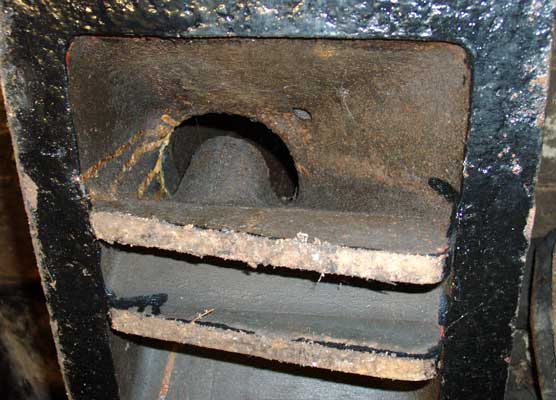 |
The base of the exhaust manifold clearly showing the swirl walled Kordina. 04 December 2005 |
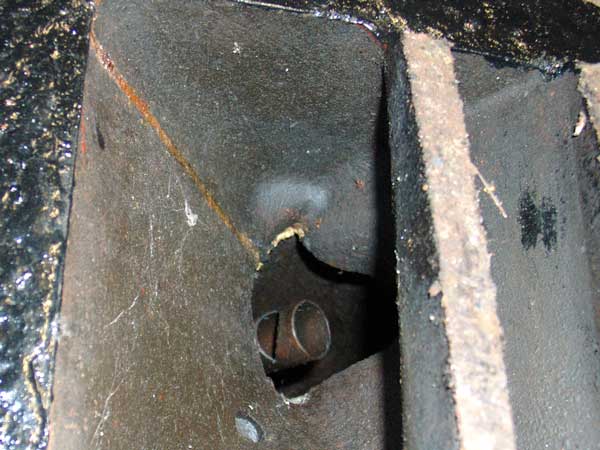 |
A view from the other side showing the Kordina and exhaust steam take off for clinker control steam. 04 December 2005 |
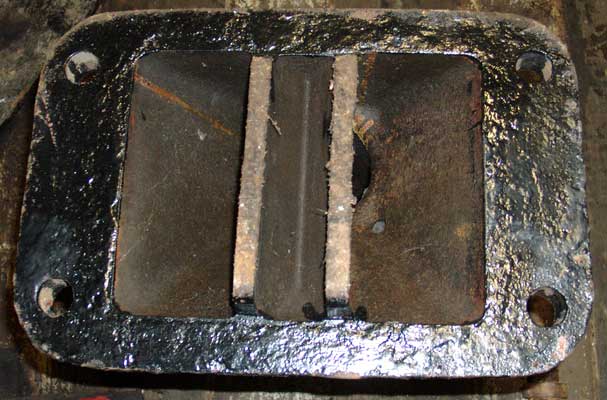 |
A clear shot of the manifold base.04 December 2005 |
Bolted to the top of the Kordina was the first stage of the Kylpor exhaust splitter - an item shaped much like a Maltese cross. Above this was the second stage of exhaust splitter, this time a 4 nozzle construction based on Kyläla nozzles. Above this sat the mixing chamber and diffuser, bolted to the smokebox top. These components needed to be carefully lined up to get the correct level of performance. To help achieve this the second stage of exhaust splitters were fitted with small extension pieces which lined up the splitters with the mixing chamber.
 |
A general view of the lower section of the Kylpor arrangement. This item bolts to the smokebox floor. It incorporates the Kordina and first set of exhaust splitters - in the shape of a Maltese cross. Note on the left the capped pipe which would be connected to further pipework, when assembled, to carry exhaust steam to the grate as under fire (clinker control) steam. 04 December 2005 |
 |
A view down into the nozzle. Note the Kordina and exhaust steam collection pipe. 04 December 2005 |
 |
The 'Maltese cross' viewed from the underside. 11 June 2006 |
 |
The second stage of exhaust splitters 'hangs in the air' so must be supported. The Hunslet version was supported on a pair of 'legs'. When installed this 'legs' were in line with the boiler. The item shown here is slightly damaged. 11 June 2006 |
 |
A view from the base of the second stage of splitters. The righthand side of the base has been damaged. 11 June 2006 |
The final two sections of the exhaust ejector were made as a single item. Starting with a bellmouthed entry there was the parallel walled mixing chamber where combustion gases and exhaust steam mixed. That is not to say they did not mix before this point. The Kylpor system has two points of gas entrainment - this one and between the first and second stage exhaust splitters. These two points of entrainment account for the higher frictional losses in the Kylpor over the Lempor.
From the mixing chamber the swirling exhaust gases enter the diffuser. This section forms what is traditionally known as the chimney sticking out, as it does, in part, of the smokebox. The Austerities were given a distinctive cowl covering to the diffuser very unlike the traditional form of chimney fitted to unmodified machines. This cowl was made of fibreglass.
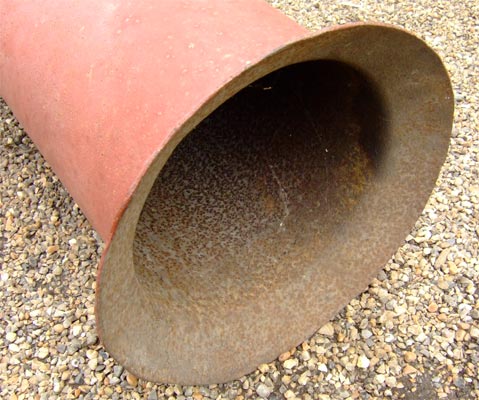 |
The second stage splitter directs the exhaust steam into the parallel walled mixing chamber section of what is traditionally known as the petticoat. The mixing chamber has a carefully shaped 'bellmouth' entry design to reduce pressure loss through excessive friction at this point. 27 June 2006 |
 |
A pair of stored Austerity one piece mixing chamber and diffusers. The mixing chamber is the parallel section whilst the diffuser is the tapered section. Current best practice, on Lempor fitted locos, is to split the mixing chamber/diffuser assembly into two piece to aid access to the tube bank. 04 December 2005 |
 |
A close-up view of the diffuser top showing the ring and holes used to fix it to the smokebox. 27 June 2006 |
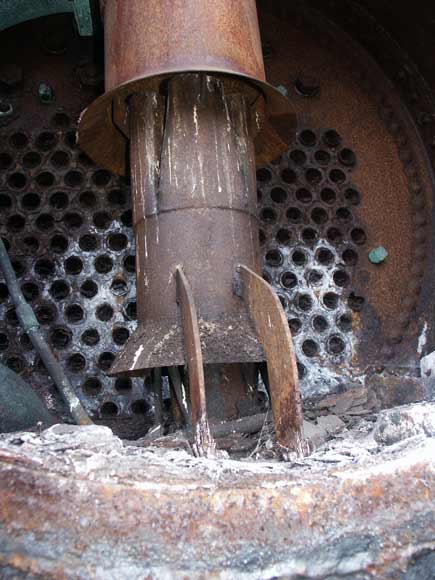 |
RSH No. 7289 'Fred' had a rather mucky smokebox when viewed in 2003! Some birds had made a home here and one of the them had not lived to tell the tale. This shot shows the two sets of Kylpor nozzles (the exhaust splitters) and the bell-mouthed mixing chamber. Note how the second stage splitters are held in position. 23 April 2003. |
 |
The Kylpor nozzles and the bottom of the mixing chamber. The lugs used to help align the system can be seen. 23 April 2003 |
 |
A good clear view of the mixing chamber and above it the tapered section forms the diffuser. It looks to be life expired. 23 April 2003 |
 |
As noted above current best practice is to split the mixing chamber and diffuser into two pieces so as to aid access to the tubes and tubeplate. In preservation this is precisely what has been done on the Embsay and Bolton Abbey Railway's Austerity 'Monckton No.1'. 11 June 2006 |
 |
A view down the chimney to the top level of Kylpor nozzles. The lower set, the 'Maltese Cross' is also visible. 13 April 2003 |
 |
The distinctive fibreglass chimney cowl and the top of the diffuser which is slightly damaged. 13 April 2003 |
A procedure clearly at odds with Porta's recommendations, but which was none the less common, saw the removal of the second stage exhaust splitters when in NCB service. It is reported that locos running in this condition, the norm for modified/partially de-modified machines in preservation, steam and pull better than a standard Austerity does. However the performance has yet to be quantified in a meaningful way. The angle of the second stage nozzles to the inside of the mixing chamber is essential to gain the required performance from the system. The loss of this second stage will have seriously impaired draughting.
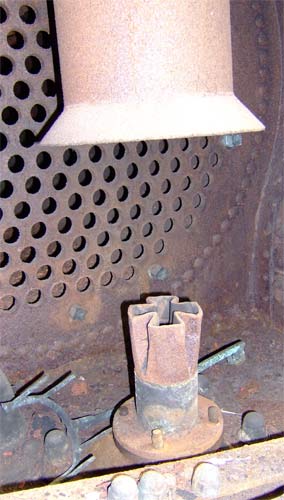 |
An example of how some locomotives ran in service and most now run in preservation. The second set of exhaust splitters are missing. 11 June 2006 |
In addition to the revised exhaust ejector a much improved blower, based on similar thinking to the Kylpor system, was employed with de Laval nozzles.
On the top of the smokebox door there was one further modification, a device allowing air into the smokebox in a controlled manner. Two explanations of this system have been forthcoming. It is believed the first is the most likely given information contained in UK Patent 953,391.
The first explanation is that a smokebox vacuum regulation system was installed. It is said this was to allow fine tuning of the smokebox vacuum to the combustion conditions. This may be all well and good in theory but in practice is likely to have been a very impractical device, especially given the lack of understanding of its true effect by the end user.
 |
UK Patent 953,391, filed by Hunslet with Porta listed as the inventor, showed a system to allow fine tuning of the smokebox vacuum. Whilst the system illustrated was not used on the Austerity type it is suspected the device on the smokebox door was indeed a vacuum regulator. |
The other description of this system quoted was that it was used to tune the amount of smoke produced. Using a Ringelmann type smoke opacity estimator the opening was altered to give the desired result. But in reality would this ever have been used in service?
Further, definitive, information would be appreciated! Is it possible that the former explanation was the true reason for the device but that that later was found to be a useful effect of the design?
 |
All
the modified Austerities had a device on the smokebox door allowing the
amount of smokebox vacuum to be altered and or the smoke opacity to be set. It is questionable as to whether this was a Porta inspired modification. Fred retains the fitting but
it is blanked off. 23 April 2003 |
Valves and Valvegear
These machines were built with Stephenson valvegear and slide valves, much like most UK built industrial steam locomotives of the era.
To reduce, by half, pressure drop when opening and closing the valves the face on the cylinder was radiused on the inlet side, remembering that having slides valves means the locomotives are of the outside admission type. Similarly the exhaust edge of the valve was also radiused.
The valvegear itself was altered from the standard type to the 'crossed-bar' type. The purpose of this modification was to increase lead steam with a shortening of the cut-off.
Lighting Up
To assist with steam raising it was possible to attach a compressed air supply to drive the stoker and provide a draft via the blower ring. When pressure was sufficient the air would be turned off and the system would return to operation by steam.
Testing
On 06 September 1962 the first locomotive, Hunslet No.2876, was sent to Waterloo Main Colliery, Leeds having been outshopped a shot time before. Testing was, of course, undertaken to assess performance and allow tuning up. Some of this work was undertaken with Porta in attendance. By March 1963 No.2876 had acquired the painted-on name 'Jess'.
Porta is known to have been a good friend of Hunslet's Keith and John Alcock, joint Managing Directors at this time. More information on Porta's 1963 visit and the work undertaken would be very gratefully received.
Locomotive
No.3883 was sent to BR Swindon in late January 1963. From the 9th to 16th February 1963 No.3883 was utilised as Swindon MPD pilot loco. This period allowed experiments to be undertaken with various coal sizes. On the 17th February the loco was formally handed over to the BR Research Department (Swindon) for controlled road test. The testing was undertaken over the approximately 18 miles stretch of mainline between Yarnton and Kingham on the Oxford - Worcester mainline, today called the Cotswold Line. Most testing is thought to have been undertaken in April however the loco was noted on test as late as June 1963. The normal test load was Swindon's Hawksworth era dynamometer car, 38 4 wheel vans and two brakes. As the locomotive was not fitted with continuous brakes all testing was undertaken loose coupled. During the test period, on 28th April, the loco was noted under repair in the former GWR workshops at Swindon but the reason is currently unknown.
 |
No.3883 during testing on the Western Region of British Railways. This photo is believed to have been taken at Oxford locomotive depot where the Austerity was in the company of a couple of BR Standard type locos. 1963. Photographer unknown. If you are the photographer or hold the copyright and object to this photo being used here please contact me. |
The tests demonstrated that No.3883 was significantly improved over a standard type loco. A steaming rate
of 12,000lbs/hour (5443kg/hour) was found to be sustainable. An unmodified loco
would struggle to produce 6000lbs/hour (2722kg/hour.) A maximum output of 898hp
(670kw) was recorded, a very impressive figure for what was a shunting locomotive. These tests were the last time a steam locomotive was formally tested by British Railways with a dynamometer car.
No.3883 was originally outshopped as Hunslet No.2868 in 1943. was one of the locos heavily rebuilt by Hunslet. Having been bought back by Hunslet the locomotive was returned to 'as new' condition and modified. As a result of this work No.2868 became No.3883 of 1962. Quite a few locos were bought by Hunslet, rebuild and issued with new works numbers at this time. Not all of the rebuilds were fitted with the modifications. The following table of rebuilds which included the modifications is taken from the Industrial Railway Society 'Industrial Railway Record' February 1969:
NEW HUNSLET WORKS No. |
NEW BUILD YEAR |
ORIGINAL MAKER & No. |
3880 |
1962 |
RSH 7139 |
3882 |
1962 |
HE 2890 |
3883 |
1962 |
HE 2868 |
3884 |
1963 |
RSH 7204 |
3885 |
1963 |
HE 3163 |
3886 |
1963 |
HE 2897 |
3887 |
1964 |
HE 3193 |
3888 |
1964 |
HE 3192 |
3891 |
1965 |
HC 1763 |
3892 |
1969 |
RSH 7136 |
|
Original makers:
RSH - Robert Stephenson & Hawthorn
HE - Hunslet
HC - Hudswell Clarke
|
No.3883 is now preserved at the Rutland Railway Museum.
Modified Austerities became the last two locomotives built from new in the UK for industrial service in the UK. These machines were given Hunslet works nos. 3889 and 3890. As can be seen from the above list these two last locos, both dating from 1964, are not numerically the highest however nos. 3891 and 3892 were both officially classed as rebuilds rather than new builds.
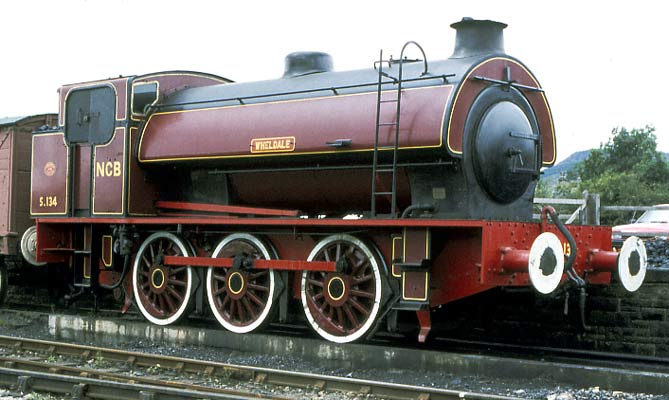
Austerity
S.134 'Wheldale', Hunslet No.3168 of 1944, in Embsay yard. This loco is now largely de-modified. 06 August
1990
Unsurprisingly Hunslet were keen to promote their innovations through adverts and sponsored articles. Below are a number of these. Click on each image to open a larger version (each ranges from 64kB to 152kB):
In his authoritative history 'The Hunslet Engine Works' Don Townsley states that in total 83 locomotives received the underfeed stokers and, it is assumed, at the same time Kylpor exhaust ejectors and one of the two forms of overfire air provision for the GPCS. Not all of the modified locomotives were of the 'Austerity' type. The other types modified were:
- 11 Standard 15" Hunslets
- 4 Standard 16" Hunslets
- 1 50550 type Hunslet
- 7 Hudswell Clarke 17" 0-6-0t
So a total of 60 Austerities and 23 other types of locomotive were ultimately modified. These are somewhat different figures to those normally quoted.
All types modified are represented in preservation but in varying states of de-modification.
Other attempts at modifications were undertaken during this era. Whilst these fall outside the remit of this page a couple of the 'better' ones are worth listing. Readers are left to ponder the thinking behind these ideas and the technical shortcomings:
-
Provision of secondary air via pipes in the front of the smokebox feeding back down boiler tubes to the firebox.
-
Provision of a 'blower ring' ABOVE the chimney to mix steam with exhaust gases to reduce the appearance of smoke and thus get around the clean air regulations.
-
An underfeed stoker driven by a separate diesel engine which also force draughted secondary air into the firebox.
-
At least 15 Austerities and a number of other types were fitted with the Giesl exhaust ejector since shown to be thermodynamically inferior to the Kylpor. The first Giesl was fitted in 1959, several years before the Gas Producer modifications started.
Fred In Service on the Keighley and Worth Valley Railway
A few archives shots of Fred operating in preservation:
 |
Fred on shed at Haworth. 1975. © Roger Griffiths |
 |
Fred and 2-6-2t 41241 emerge from Ingrow Tunnel. As would be expected from Fred combustion appears to be spot on. March 1976. © Roger Griffiths |
References:
Chapleon, A.: La Locomotive a Vapeur, 1952 edition translated by Carpenter, G. 2000.
Conversation with Adams, C., Embsay and Bolton Abbey Steam Railway.
Conversation with Sanderson, D., Embsay and Bolton Abbey Steam Railway.
Hunslet Austerity Locomotives Spare Parts List. Hunslet 1946, reprinted 2006 by Camden Miniature Steam Services
Industrial Railway Record, February 1969. Available online here.
Lambert, A.P. & Woods, J.C.: Continent, Coalfield and Conservation. 1991
Porta, L.D.: Steam Locomotive Power: Advances Made During the Last Thirty Years. The Future. 1990, translated, from French, and with additional comments 1991.
Railways Illustrated. No. 61.
Railway Magazine. August 1963.
Railway Magazine. January 1990.
Railway Magazine. February 1992.
Townsley, D.H.: The Hunslet Engine Works. 1998.
UK Patents: 873996, 888793, 929486, 937719 & 953391.
Wardale, D.: The Red Devil and Other Tales from the Age of Steam. 1998.
Close Window




























 Taken from the writing's of L.D.Porta:
Taken from the writing's of L.D.Porta:


























